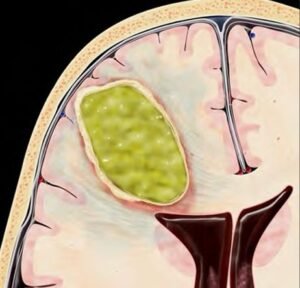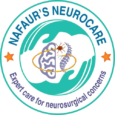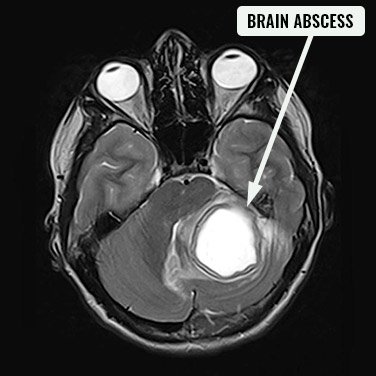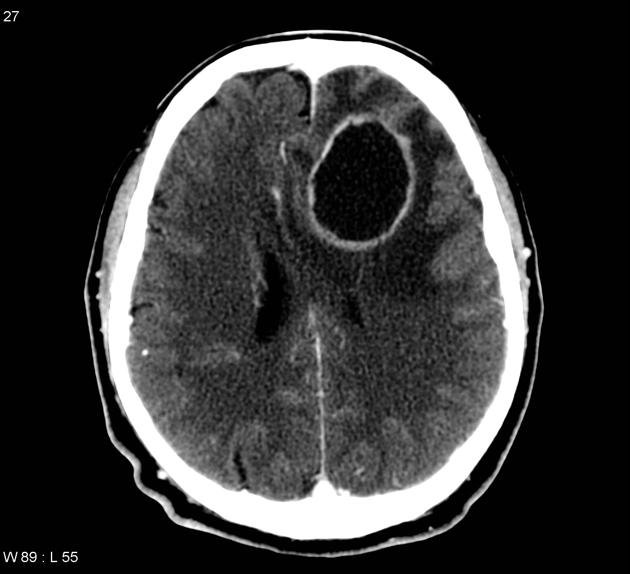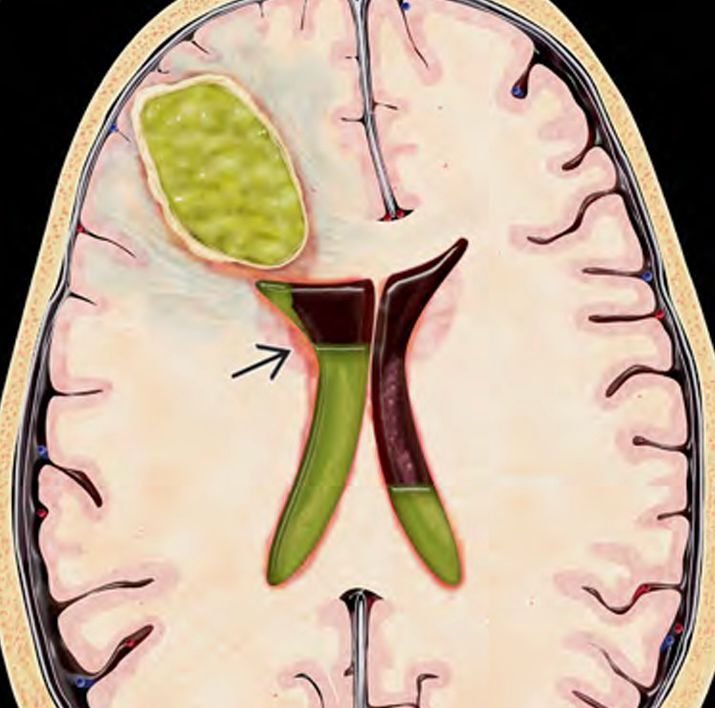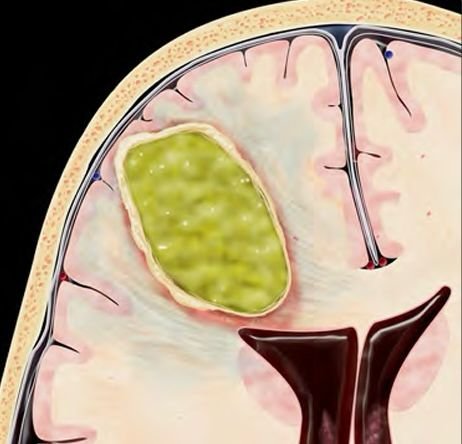Brain Abscess
Brain Abscess
A pediatric brain abscess is a life-threatening accumulation of pus and infected material inside the brain caused by bacterial, fungal, or parasitic infection. It results from inflammation and infection of brain tissue and often arises due to the spread of infection from the ears, sinuses, or blood. This condition is more dangerous in children, especially when diagnosis and treatment are delayed. Brain abscess in children can lead to seizures, raised intracranial pressure, coma, and even death if not treated quickly. In Bangladesh, due to poor infection control, delayed diagnosis, and a shortage of pediatric neurosurgeons, brain abscess remains a critical pediatric neurosurgical emergency. Dr. Md. Nafaur Rahman, a leading pediatric neurosurgeon in Bangladesh, has extensive experience in diagnosing and managing complex brain abscesses in children using both advanced neuroimaging and minimally invasive neurosurgical techniques. 🌍 Brain Abscess in Children – Bangladesh Context In Bangladesh, pediatric brain abscesses are more common than in developed countries due to: ❌ Untreated ear infections (otitis media) and sinusitis 💧 Poor sanitation and chronic parasitic infections 🧬 Undiagnosed congenital heart defects (especially cyanotic heart disease) 🧫 Inadequate antibiotic coverage in systemic infections ⏱️ Delayed access to neuroimaging or neurosurgery in rural areas Dr. Nafaur Rahman has played a key role in increasing awareness, performing life-saving surgeries, and providing follow-up rehabilitation for affected children across Bangladesh. ⚠️ Symptoms of Pediatric Brain Abscess Symptoms vary based on the abscess's size, location, and the age of the child, but common signs include: 🌡️ High-grade fever and vomiting 😵 Headache, often severe and progressive 🧠 Altered consciousness or confusion 🧒 Bulging fontanelle in infants ⚡ Seizures (new-onset in a healthy child) 🧍♂️ Weakness or paralysis on one side of the body 👁️ Visual disturbances or squint 🧑🦽 Difficulty walking or poor coordination “If your child has a high fever and seizures or shows behavioral changes, a brain infection must be ruled out immediately.” — Dr. Md. Nafaur Rahman 🧬 Causes of Brain Abscess in Children Common Sources of Infection: 👂 Chronic ear infections (otitis media/mastoiditis) 👃 Sinusitis or nasal infections 💓 Cyanotic congenital heart disease 🩸 Septicemia or bloodstream infections 💥 Head trauma or post-surgical infections 🦠 Parasitic infections (toxoplasmosis, neurocysticercosis in rural areas) 🧪 Diagnostic Tools at NINS & Bangladesh Paediatric Neurocare Centre Accurate diagnosis is vital for life-saving treatment. Dr. Nafaur Rahman’s centers are equipped with modern neurodiagnostic tools to confirm and localize the brain abscess: Key Investigations: MRI Brain with Contrast – Best tool for detecting abscess, edema, and mass effect CT Scan Brain – Quick and effective for initial diagnosis, especially in emergencies Blood culture, CBC, CRP, ESR – To identify source and type of infection CSF analysis – In selected cases (when there is no risk of brain herniation) Echocardiography – To detect congenital heart disease ENT evaluation – To identify infection source in ears or sinuses 🛠️ Surgical and Medical Treatment of Brain Abscess The goal of treatment is to control the infection, relieve pressure on the brain, and preserve neurological function. Treatment involves a combination of surgery and antibiotics. 🧠 Neurosurgical Interventions by Dr. Nafaur Rahman: Stereotactic Aspiration / Burr Hole Drainage Minimally invasive drainage using image guidance Relieves intracranial pressure and improves symptoms rapidly Suitable for accessible and encapsulated abscesses Craniotomy and Excision Performed when the abscess is multiloculated or recurrent Complete removal under microscopic vision Ensures better control in large or deeply seated abscesses CSF Diversion (VP Shunt) Required if hydrocephalus develops secondary to abscess or edema Prevents buildup of fluid and improves long-term outcomes 💊 Antibiotic Therapy: Broad-spectrum IV antibiotics for 4–8 weeks Targeted based on culture sensitivity May include antifungals or antiparasitic agents depending on the cause 🔁 Long-Term Follow-Up and Rehabilitation Even after surgical recovery, long-term care is essential for proper neurological development: 🧠 Neuroimaging follow-up every 3–6 months 🧒 Developmental assessment in infants and toddlers ⚕️ Seizure control and tapering antiepileptic drugs 🗣️ Speech therapy, physiotherapy, or cognitive support 📚 Support for school re-entry and behavioral therapy if needed 🚨 Dangers of Untreated Brain Abscess in Children Without proper treatment, brain abscess can result in: 🧠 Severe brain damage or herniation 🧑🦽 Paralysis or permanent neurological deficit 🛌 Seizures and developmental regression ⚰️ Death from rupture or septicemia “Brain abscess is one of the few neurosurgical emergencies where early intervention can prevent a lifetime of disability. Delay can be fatal.” — Dr. Md. Nafaur Rahman 👨⚕️ Why Choose Dr. Md. Nafaur Rahman? 🧠 One of Bangladesh’s most experienced pediatric neurosurgeons in infectious brain diseases 🏥 Practices at National Institute of Neurosciences & Hospital (NINS) 💉 Expert in minimally invasive brain abscess drainage and craniotomy 🧒 Child-focused care including infection control, rehabilitation, and family support 🌍 Provides services in both public and private settings, ensuring access for all families 📞 Contact for Emergency Pediatric Brain Infection Management Dr. Md. Nafaur Rahman Assistant Professor, Pediatric Neurosurgery, NINS Chief Consultant, Bangladesh Paediatric Neurocare Centre 📱 For Serial/Appointment: 📞 01912988182 | 📞 01607033535 🌐 Website: www.neurosurgeonnafaur.com
